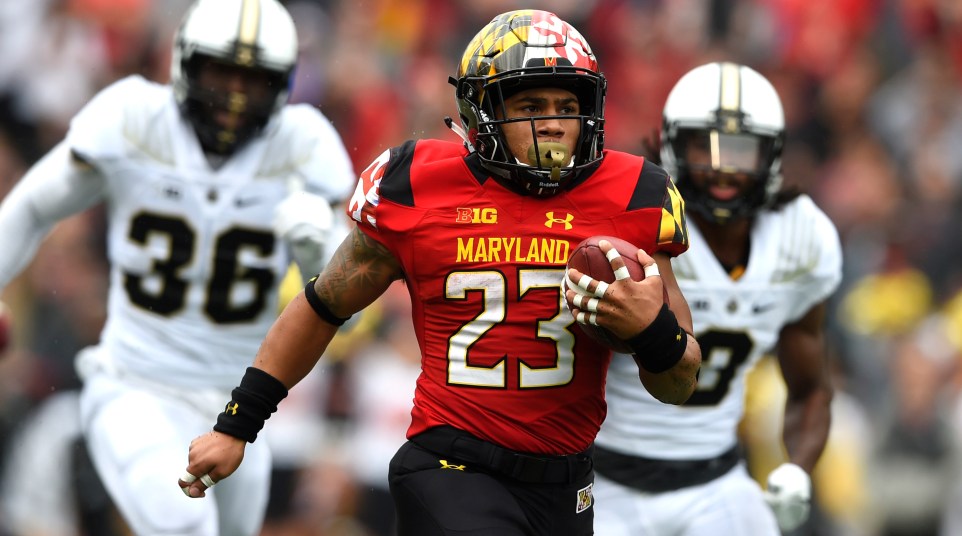Five observations from Maryland's spring game
If you were hoping for answers from Maryland’s spring game on Saturday, you were probably pretty frustrated. Especially if the questions surrounded the quarterback and passing game.
Most of the things that we already knew were confirmed. The things we hoped we would’ve learned more about? Well, those are going to have to wait until fall.
But, there were still a few things that were noteworthy as D.J. Durkin and the Terrapins closed out the spring season on Saturday. Here are five takeaways:
The starting quarterback wasn’t on the field
Max Bortenschlager and Tyrrell Pigrome were expected to be competing for the starting job up through the fall. After Saturday, I’m not so sure that’s the case.
Both passers struggled with accuracy and weren’t able to get much air underneath the football. Sure, the gloomy weather conditions played a role, but the inconsistent effort was hard to ignore.
Trust us: This @TerpsFootball highlight INT wasn’t as easy as Antoine Brooks made it look. https://t.co/fuuU4dq7T2
— Maryland On BTN (@MarylandOnBTN) April 22, 2017
Pigrome and Bortenschlager had their moments with a few nice touchdown passes in the game, but it’s hard to believe that Caleb Henderson – who sat out due to an ankle injury – and Kasim Hill won’t provide more stability for the Terrapins under center.
We won’t know what happens until the fall, but Henderson and Hill are probably the favorites to start at quarterback in September.
Stopping the run still looks like an issue
It didn’t matter who took the handoff, most of Maryland’s running backs enjoyed a pretty nice afternoon. That’s slightly worrisome for a defense that surrendered 214.8 yards per game on the ground a year ago, which ranked 11th in the conference.
To win in the B1G, stopping the run – or at least slowing it down – is extremely important. Through the spring, it doesn’t look like the Terrapins have made much progress.
With Maryland faced against one of the most difficult schedules in the country next fall, it’s going to be crucial that it finds a way to start winning the battle at the line of scrimmage against the run.
Lorenzo Harrison’s return should lead to big things for the running game
It seems like every team in the B1G has a pretty solid one-two punch in the backfield and Maryland is no exception. The return of Harrison is big for the offense.
After serving a four-game suspension at the end of the 2016 campaign, Harrison was in mid-season form, eluding defenders and breaking tackles to churn out a couple big plays. When he got the ball, he demonstrated excellent field vision and a great ability to escape potential tackles. He even turned a routine run into a 56-yard scoring play.
You see the hole Lorenzo Harrison had on this @TerpsFootball TD run, and it’s no wonder he took it to the house. https://t.co/WMdR42Z85n
— Maryland On BTN (@MarylandOnBTN) April 22, 2017
Harrison and Ty Johnson will probably see a similar number of carries this fall, which should be a really good thing for the offense. The Terps ranked fourth in the B1G in rushing yardage last season and could be even better this year.
A fast-paced offense is taking over
It looks like the goal of Walt Bell’s offense will be to wear down defenses. That was evident in the spring game as Maryland ran 72 plays and huddled infrequently. That style seemed to work pretty well later in the game when Bortenschlager and Pigrome were completing passes and running backs were picking up yards by the chunk.
That type of offense can work in the B1G but the consistency at quarterback is critical. If completion percentages are low, it won’t matter how quickly Maryland’s offense is getting to the line.
On the positive side, though, the running backs and offensive line appeared to click with a quicker pace, which is a really good sign. If it is Henderson or Hill that’s under center this fall, completion rates shouldn’t hinder the offense’s pace much at all.
While we’re talking about offense, how about guys in the trenches?
This was kind of a pleasant surprise in the spring game. Not that Maryland’s offensive line was good, but that it seemed comfortable in most situations.
The quicker pace didn’t seem to bother the guys up front, who did an excellent job creating holes and blocking downfield. Quarterbacks weren’t exposed to much pressure throughout the day, either.
Most importantly, though, the offensive line didn’t seem fatigued as the game continued. Of course, playing 12 minute quarters with a running clock might not provide the best circumstances for evaluation.
Still, the Terrapins offensive line play should be an advantage this fall.

